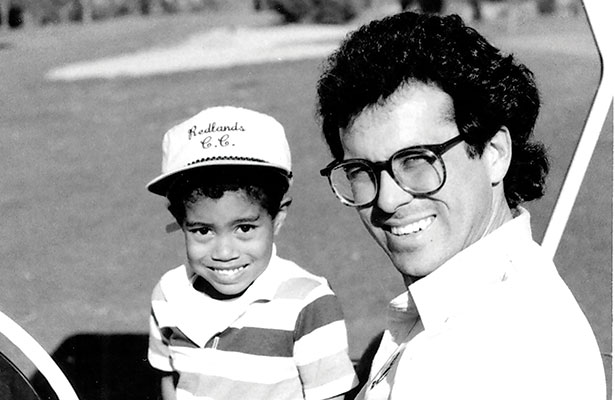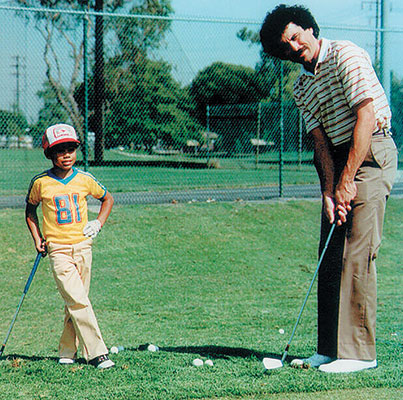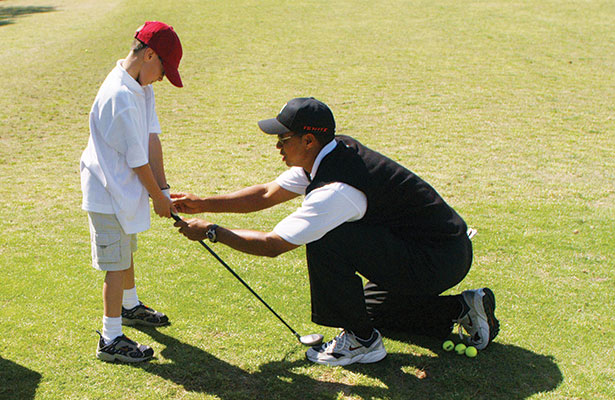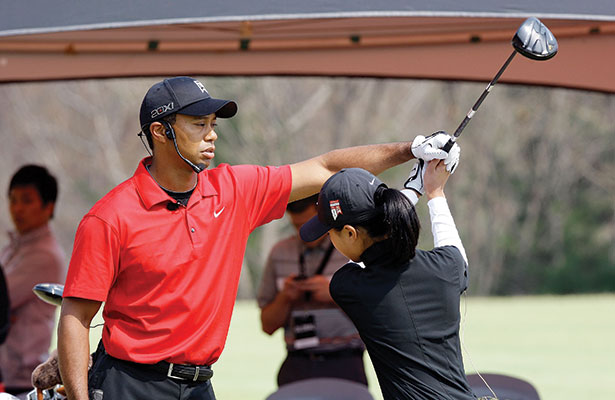Rudy Duran has been a golf coach in southern California for more than four decades. But one particular day in 1979 changed his outlook on the game.
Not because the 4-year-old who walked into Heartwell Golf Park’s pro shop asking for lessons was Tiger Woods. Nor the fact Woods teed up four balls and executed as many perfect golf shots. The reason was, quite simply, that everything Duran thought he knew about the golf swing went out the window.
“I HAVE been a golf pro for 44 years and I discovered there was no magical technique to the golf swing,” says Duran.
“Prior to working with Tiger, I used to think learning to hit the golf ball was like a formula; once you had it you’d always hit straight.
“But I was frustrated because that never really happened. When Tiger came along, I realised it wasn’t an intellectual formula but more natural ability.”
Speaking with Australian Golf Digest from his California home, Duran recalls the initial shock at a toddler possessing the skills of a 5-handicapper.
“I teed up four balls for Tiger and he went bam, bam bam, bam! Four perfect shots in a row. The drives went about 60 yards (55m) with a bit of draw,” says Duran.
“Then I took him to the chipping green and to hit some pitch shots and he was already hitting high shots and low shots at that age. It was quite special.”
Then, an epiphany hit: “First you learn to play golf, then you learn how to play better.
“I learned kids are not broken – I don’t need to teach them my technique; I need to help them find their technique. Certainly Tiger Woods put an exclamation point on that.”

Duran, now the director of instruction at Chalk Mountain and Morro Bay golf courses (between Los Angeles and San Francisco), used this philosophy as the premise of his popular children’s instruction book, In Every Kid There Lurks a Tiger.
“A common mistake in golf instruction is trying to get kids to have perfect stances, grips, postures and swing planes before they start playing,” says Duran. “I try to get them to swing the club on the course first, so they can learn the context. I want to help kids play the best they can with the swing they’ve got. “Another mistake is teaching on the driving range too much and not taking them on the course, so the kids aren’t learning to play golf. The driving range is not golf. It’s not a golf environment.”
So what does this old-school swing coach make of golf’s newest faculty – biomechanics – and the fact his former pupil has immersed himself in it?
“I don’t have a problem with (biomechanics), but you don’t need that to play golf,” says Duran. “Why would we make it a science project? If you’re an elite athlete who wants to maximise your individual ability, then that’s great. But you can just go out there and play and it’s a lot of fun.”
Duran’s argument has a strong case. Woods’ best years – from his rapid rise in the late 1990s, to winning four consecutive Majors in 2000/2001, and spurts of greatness between 2005 and 2008 – were performed without the study of human motion.
Regardless, Duran is just grateful to have contributed to Woods’ remarkable era of 14 Major championships.
“It’s nice to think about I played a little part in that; it’s a nice feeling,” says Duran. “The most important thing was that I got to spend time with a great player. To watch the shots he hit as a young kid … I got way more out of it than he did.”

But can Woods, 39, get back on track in his quest to better Jack Nicklaus’ record 18 Majors? “Absolutely; Tiger can win a whole bunch of Majors; he’s only 39 and in great shape. It wouldn’t surprise me if he won 14 more Majors and another 79 tournaments.”
And while the world’s leading instructors offer solutions to Woods’ mechanical issues, Duran’s doesn’t even involve a golf swing.
“I’d interview him. I try to interview players to see what’s important to them, and help discover their best player inside them – Tiger is a great player; he’s not broken.”
Perhaps the resolve lies in Tiger rediscovering the childhood rounds he cherished at that beloved par-3 course in Long Beach, California.
“Golf can get way too serious,” says Duran. “What’s wrong with having nice walk on the course, spending time outside, exercising with family and friends and hitting the ball around? That’s golf.”

the Tiger Woods Foundation.
Rudy Duran On…
- Tiger’s personality: “He’s a charming man and just fun to be around. If I go to a US PGA Tour event and I see him, he’s always gracious when he comes up to me and says something endearing. I got an award from the tour once and he was my presenter. He told a funny anecdote from our days in southern California.”
- The ideal golf build: “I’ve realised you don’t need to be of a certain age, or size, to play golf. Anybody can play great golf and that’s not possible in a lot of other sports. Tiger wasn’t even big for his age at 5 and he could play great golf. In the past, golf pros thought there was an ideal size like Ben Hogan. We used to say things like, ‘He has great touch for a tall man.’ Why would we say that? Why wouldn’t a tall man have great touch?”
- Tiger’s prodigious talent: “Tiger really was masterful at playing golf. He was hitting amazing shots as a 5-year-old. He was using strategy, picking his own clubs, and playing the ball as it lies – things you don’t see at age 11 or 12 with other kids. Tiger was unique.”
- If he had his timeover with Tiger: “I would do the same thing if a 4-year-old Tiger came to me tomorrow – I’d just do it better! It took me a little while learning as I went. I might have even been stricter with club fitting; that’s so important.”
- How Tiger can come back: “I don’t know if he needs to ‘get back’ because you can’t go back. I think he’ll be looking forward and I trust whatever he thinks he should do. He’s Tiger Woods and nobody else is; whatever he thinks I support.”
Three Golf Teaching Essentials For Kids
1. Environment: “The most important thing for teaching kids golf is a student-centred environment where they can have fun. This environment could be a golf course short enough for them to play and tees closer to the hole – and it can’t be too expensive, either. With Tiger, he played off the same tees I would, except I created a ‘Tiger Par’ which I determined on each hole depending on how many perfect shots he hit. That allowed him to compete with me. The environment also has to be activity-based, with things kids might experience in the playground. Juniors should learn golf in a lighthearted and easygoing environment.”
2. Club fitting: “This is huge – kids need to have clubs that fit them. They don’t grow into clubs that are too long for them. Just like shoes – you don’t get shoes three inches too big. Every time a child grows 1.5 inches, the club has to lengthen an inch. Not many people know this, but the other clubs are proportionate to the driver – a wedge’s length should be 78 per cent of a driver. So when you change their driver, your need to change their wedges and the other clubs.”
3. Access to the golf course: “You have to give kids access to the golf course and not just two hours a week. I tend to give my first lesson on the course if the kids are mature enough. Here, they can learn to actually play the game and not just swing a club at a driving range with no context. Start near the green, so they can get the ball in the hole and learn golf etiquette, then start going back farther. You have to have a coaching program that allows this kind of access to the course and I think club pros these days do a great job of letting the kids have fun, but I’d like to see them more on the golf course.”




